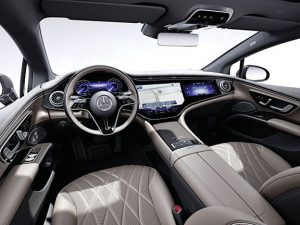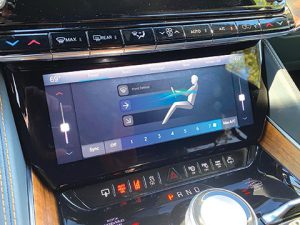Bloomberg
As recently as 10 years ago, touch screens in cars were tiny — if they were there at all. Most were grudgingly added by automakers in anticipation of a US mandate on backup cameras, or an early response to Elon Musk, who dropped a 17-inch monitor into a Tesla in 2012. Destinations were largely DIY, mapped on a plugged-in GPS device
or chirped from an iPhone jammed in the cupholder.
Fast forward a decade and touch screens are no longer a reluctant add-on or an innovative auto perk; they’re table stakes. Some 97% of new cars globally have at least one touch screen, and they are metastasising quickly. Almost a quarter of US cars and trucks now have command displays spanning 11 inches or more, according to S&P Global Mobility; luxury brands are now normalising a separate screen for passengers. And nowhere is this arms race more evident than in electric vehicles. As battery-powered motors commodify driving — giving sports car-level superpower to giant pickups and tiny hatchbacks alike — the center-stack display offers the biggest, brightest space to stand out. The only question is, at what cost?
In an electric car, the capacitive pane is the nerve center of the vehicle: It handles virtually every command and diagnostic, from reading tire pressure to plotting the best charging stops. It also manages a suite of adjustments that in gas-guzzlers were traditionally tied to buttons and knobs. If a driver wants to adjust her side mirrors, for example, she often has to tap the screen.
For Tesla, the decision to throw in a touch screen may have been as much about constraining cost as it was about setting a new standard. When a computer can take over analogue adjustments, the company doesn’t have to make as many precious switches and toggles. What’s more, features can be iterated via over-the-air software updates.
Younger startups saw the magic in Musk’s math. As Rivian, Lucid and others stood up their own assembly lines, touch screens and the corresponding stack of coding offered an end run around much of the supply chain. Today, Rivian’s new R1T pickup boasts a touch screen spanning 15.3 inches from corner to corner. Lucid’s Air has a 34-inch “cockpit display.†Tesla’s Model S still has its 17-inch pane, but now it tilts from side to side and
has souped-up resolution for playing video games.
For auto incumbents, meanwhile, giant screens are increasingly imperative, particularly in the EV game. Consider Ford Mustangs: In 2021, the gas-burning version came with a 4.2-inch display, while the Mustang Mach-E, an all-new battery-powered machine, boasted a 15.5-inch screen. In the batch of new EVs from Mercedes, nearly the whole dashboard — 56 inches of width — is made of three separate touch-screen displays and eight computer-processing units. The suits in Stuttgart call it the “Hyperscreen.â€
General Motors also dialled the screen to 11 for its Hummer EV. There’s a 13.4-inch display in the center of the cockpit and another 12.3-inch pane in front of the driver. Change the drive mode and screens play a short animated video of the truck crawling over obstacles like a football robot in an NFL promo.
More recently, the giant displays have become a convenient way to sell subscription services and tout new features like customised driving modes.
But a technology can isn’t necessarily a technology should. Ironically, a lot of drivers don’t love these totems — or at least don’t love how they work. Every few years, Consumer Reports asks tens of thousands of people how they feel about their cars’ so-called infotainment systems. Every time, the largest, flashiest packages rank near the bottom in terms of satisfaction.
While backup cameras have been a safety success, the arms race they kicked off also appears to be increasingly dangerous. There’s ample evidence that futzing with a giant dashboard display while driving isn’t much safer than tapping at a smartphone.
For auto executives, flashy touch screens are a great way to highlight new features, but that can come at the expense of more pedestrian stuff. Making massaging seats and ambient light patterns as easy to find as climate controls may be helpful at the dealership, but proves less so in daily use.
In time, the slouching giant center screen may not hold. Last month, BMW unveiled a screenless concept car, dubbed Vision Dee, built around voice controls and an augmented-reality display that projects navigation prompts and other information on the windshield like so many Pokemon.
BMW’s current cars, even those with touch screens, also use a combination of maintained haptic switches, fine-tuned voice control and in some cases gesture control. If the driver wants to turn up the volume in the new iX, for example, he can simply twirl his finger in front of the dashboard. Still, the carmaker’s screens aren’t tiny — nearly 15 inches on its top models. BMW also recently integrated YouTube and cut a deal to stream German matches in its i7 sedan, though both are disabled when the vehicle is underway.
Mercedes says the Hyperscreen, despite its size, can serve as an antidote to distraction: The system uses artificial intelligence to eliminate tedious scrolling. If the driver calls the same person at the same time every week, for example, the screen will prompt them at the appointed hour.
Rolls-Royce is already giving its displays a vibe check. The company’s seminal electric model comes with an understated, horizontal screen; chief executive officer Torsten Muller-Otvos says it’s in part to make the cockpit a sort of sanctuary.
For other brands, however, there’s still dashboard real estate to cover. S&P analyst Anna Buettner says the future of car cockpits is most evident in China, where Byton, a startup, has essentially built a 48-inch wide computer on top of the dashboard. “They have all kinds of stuff we’re not seeing here yet — rotatable screens, pillar-to-pillar screens across the whole car,†Buettner says. “All of that is definitely coming.â€
 The Gulf Time Newspaper One of the finest business newspapers in the UAE brought to you by our professional writers and editors.
The Gulf Time Newspaper One of the finest business newspapers in the UAE brought to you by our professional writers and editors.


